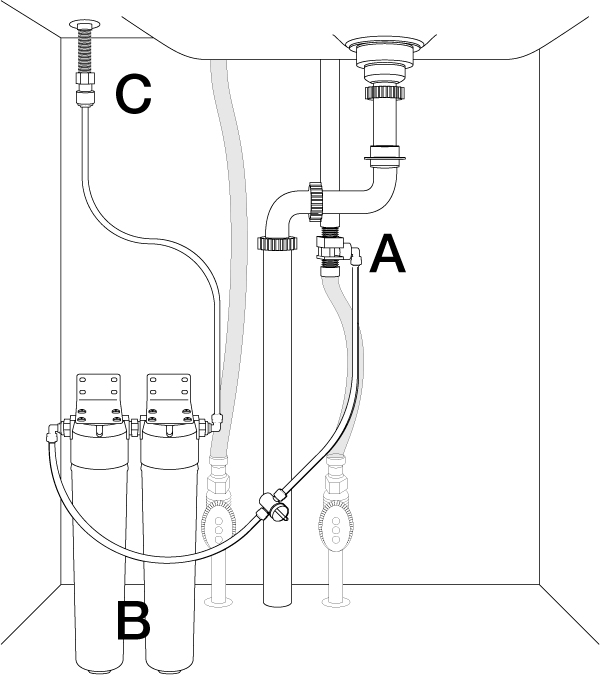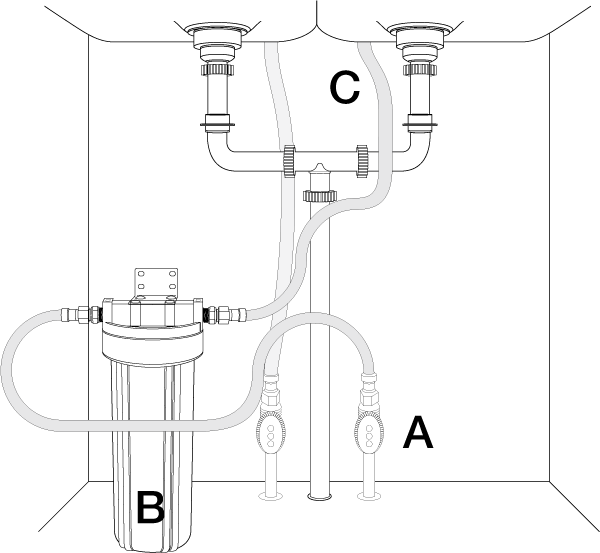How Undersink Water Filters Work

This discussion applies to water filters mounted under the kitchen sink, but not to undersink reverse osmosis units. Reverse osmosis is described in a separate section.
Unlike reverse osmosis, filters process water on demand and do not need a storage tank or a connection to a drain. There is no water usage. Every drop that goes into a water filter comes out as usable water.
Pictured above is a conventional undersink filter. It gets its water from the undersink cold water pipe at point A, then sends it via a flexible plastic tube to the water filter (B), It leaves the water filter through a flexible plastic tube and is delivered to the user through the filter's own special faucet (C), mounted on top of the sink.
The system is under constant pressure so that when the user opens the filter's faucet at the sink water flows through the filter and out the faucet.
Only drinking water delivered via the special faucet is filtered. The sink's regular cold and hot water functions remain independent of the filter.
Simple undersink filters

The filter pictured above has a different delivery system. In this arrangement the entire cold water supply for the sink is diverted through the filter and filtered water is dispensed through the regular cold water sink faucet. The hot water remains unfiltered.
The simple version without a separate ledge faucet is becoming more popular and more practical with the advent of flexible rather than hard copper undersink piping. Flexible delivery pipes make installation of simple undersink units very easy and inexpensive.
Conventional |
Simple |
| More expensive. Needs its own faucet. | Less expensive. No additional faucet needed. |
| Hole needed in sink for faucet installation. | No hole needed for additional faucet. |
| Filter cartridges last longer because only drinking and cooking water is filtered. | More frequent cartridge replacement since all cold water is filtered. |
| Higher quality water can be produced due to reduced flow rate. | Higher flow rate makes some filtration tasks less practical. (Fluoride or bacteria reduction, for example.) |
| Installs easily on either all-copper or flexible piping. | Can be installed on any undersink piping, but it's much easier where flexible connectors are used. |
| Greater model choice available because of reduced flow rate. | Only full-sized filters with 3/8" or larger ports should be used. |
Modern filter technology allows undersink filters to be designed that perform tasks that were once possible only with reverse osmosis. Undersink space permits the use of multiple filters that can achieve a number of objectives.
Activated carbon filtration, usually in the form of high performance carbon block filters, is the cornerstone of most undersink filters. All undersink filters should have at least one good activated carbon filter, and a good rule of thumb when choosing an undersink filter is "the more carbon the better."
Here's a brief rundown of filter types needed to achieve specific goals
Taste/odor improvement: Activated Carbon.
General Chemical Reduction, including chlorine or chloramines: Activated Carbon, including specialty carbons designed especially for enhanced chloramine reduction.
Lead and Heavy Metal Reduction: Activated carbon with metals removal resin added, or KDF/Activated carbon combination.
Arsenic Reduction: Activated Alumina or Arsenic reduction cartridge with iron oxide or anion resin.
Fluoride Reduction: Activated Alumina.
Nitrate Reduction: Special Anion resin cartridge, nitrate selective.
Hardness Reduction: Cation resin cartridge.
Sediment Reduction: Wound string, pleated polypropylene, or spun polypropylene cartridge. A variety of micron sizes are available.
Cyst (Giardia/Cryptosporidium) Reduction: A tight (one micron absolute or tighter) sediment filter, a ceramic filter, or a carbon block filter with cyst removal certification.
Bacteria Reduction: Ceramic cartridge.
pH Increase: Calcite cartridge.
Mineral Reduction: Deinonizing cartridge.
Hydrogen Sulfide Odor Reduction: Activated Carbon or Carbon/KDF.
More information about standard undersink filters.
More information about simple undersink filters.